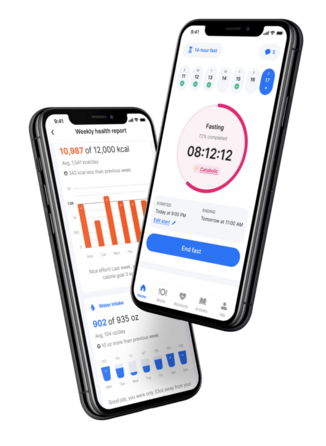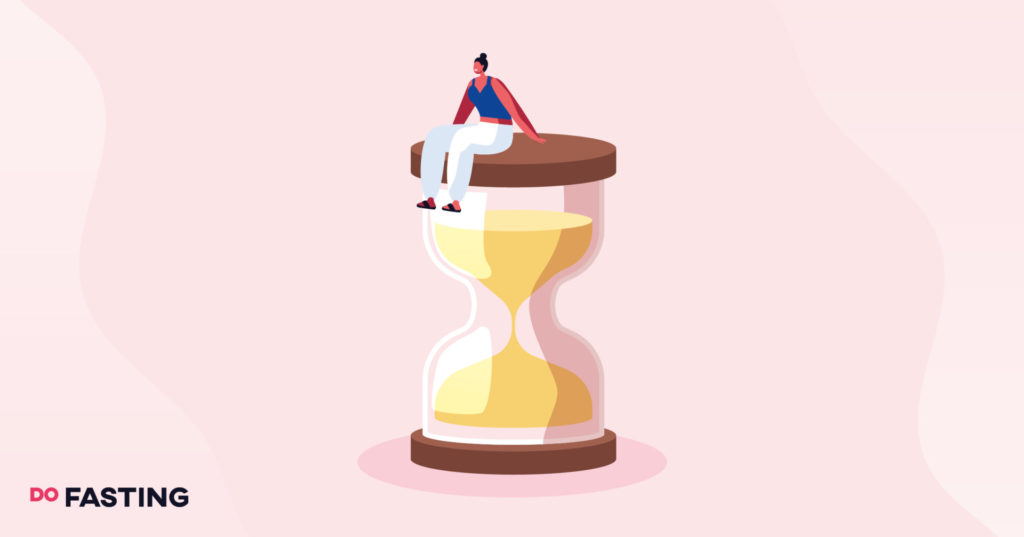Contents
What is Intermittent Fasting 14:10?
14:10 is a type of intermittent fasting. Unlike the popular 16:8 method, it has a new ratio of fasting and feeding periods. Intermittent fasting 14:10 has an eating window of 10 hours and a fasting window of 14 hours.
One common approach to doing this is to eat normally in the hours between 9 a.m. and 7 p.m. The period between 7 p.m. and 9 a.m. the next day is the fasting window. During the feeding period, you can eat your usual meals and snacks.
Likewise, during the fasting window, you are not allowed to eat any calories. However, you can drink water and unsweetened coffee or green tea.
Take a
1-minute quiz
and discover how much weight you can lose with DoFasting!

Is Intermittent Fasting 14:10 Beneficial?
Any type of fasting is more beneficial than eating throughout the day and night.
Availability of food and changing lifestyle has made it possible for us to eat anytime we want. This can cause an excess of calories, which ultimately leads to weight gain. There are several benefits of intermittent fasting 14:10, such as:
- It is easier to do. If you sleep 7 hours each day, doing intermittent fasting 14:10 requires only 7 extra hours of fasting. This certainly looks more attainable, as it has little impact on your daily schedule and social life.
- Nightly fasting for 13 hours or more reduces the risk of high blood pressure, high cholesterol, and obesity.
- If you want to level up to the 16:8 method or 24-fasts, intermittent fasting 14:10 can be an excellent starting point.
- Because it has an eating window of 10 hours, you will be less likely to experience common side effects, such as hunger pangs, headaches, and increased irritability. Even if you experience some, they will be less severe and more manageable.
Further Reading: How to Stop Intermittent Fasting Headaches Fast
Intermittent Fasting 14:10 for Weight Loss: Looking at the Scientific Evidence
Only a few studies have used the 14:10 method. That said, some studies have found that fasting for 14 hours each day can aid weight loss.
- According to a 2017 study, overweight adults who fasted for 14 hours or more lost more weight than those who had a longer eating window.
- Fasting for 14 hours or more can also improve the quality of sleep, increase satiety, and improve energy levels. All of these factors can aid in weight loss.
- An old study suggests that eating only during a 10-hour window can reduce your total calorie intake by nearly 20 percent.
- Scientists at the Salk Institute found that mice that ate a high-fat diet only during a 10-hour window lost more weight and became fit.
According to scientists, taking all your calories within the 10-hour window can help repair genetic defects associated with obesity and chronic diseases. The study appeared in the journal Cell Metabolism, 2018.
The Bottom Line
- Intermittent fasting 14:10 is easier to do and likely to provide almost all of the benefits of time-restricted eating.
- 14:10 intermittent fasting results for weight loss in men and women are promising. It not only reduces total daily calories but also improves sleep and increases satiety.
- It is more suitable for beginners. Most importantly, experts recommend intermittent fasting schedule 14:10 for women before they start doing the 16:8 method. This is crucial because going long hours without food can affect a woman’s menstrual cycle.
- Healthy eating during the feeding window is crucial. While a cheat day has little impact on your weight loss journey, unhealthy or binge eating can have devastating effects. Thus, make sure to avoid taking too much sugar or saturated fat and watch your portion size.
- Some people may not achieve their weight loss goals only with intermittent fasting 14:10. If you are one of them, add a suitable exercise regimen to your schedule. Alternatively, consider fasting for 16 hours each day.
- Seek professional help if you think a certain IF method is not giving you the desired results. Click HERE to get your personal intermittent fasting plan.
Take a
1-minute quiz
and discover how much weight you can lose with DoFasting!

See how DoFasting will improve your life
Find out what works for you with this 60-sec quiz approved by our experts and get your personal revolutionary fasting assistant.
Start the Quiz
This is an evidence-based article that includes scientific citations. DoFasting’s professional writers and editors prepared the content, which a team of medical experts verified to be accurate.















